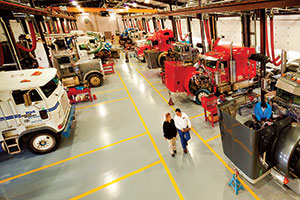Senior Reporter
Rush Q4 Net Income Rises on Fresh Demand, Cost Controls

[Stay on top of transportation news: Get TTNews in your inbox.]
Truck dealership Rush Enterprises reported net income rose and revenue slipped in the fourth quarter. The gain came as commercial vehicle markets rebounded from the industry downturn earlier in the year and stronger cost-control measures at the company were in place.
For the three months ended Dec. 31, net income climbed to $41 million, or 72 cents per diluted share, on revenue of $1.2 billion. That compared with net income of $23.7 million, 43 cents, on revenue of $1.3 billion a year earlier.
The company declared a quarterly cash dividend of 18 cents per share, a 50% increase over its dividend in the 2019 quarter,

Inside a Rush service bay (Rush Enterprises)
“As we entered the fourth quarter, solid consumer spending and strong freight rates led to increased demand for new trucks, especially from over-the-road customers,” Rush Chairman and CEO W.M. “Rusty” Rush said during the quarterly earnings call.
Additionally, fourth-quarter demand was bolstered by fewer new trucks available during the third quarter due to production shutdowns earlier in the year, leading to a 22% gain in sequential sales.
In the quarter, revenue from sales of new heavy-duty trucks rose to $458 million compared with $444 million a year earlier.
In all, it sold 10,670 new Class 8 trucks in 2020, a decrease of 28.8% compared with 2019 and accounting for 5.5% of the new U.S. Class 8 truck market.
Rush Enterprises Fourth Quarter and Year-End 2020 Results by Transport Topics on Scribd
Revenue in Q4 from sales on new Classes 4-7 vehicles, including buses, fell to $236 million compared with $279 million in the 2019 period. Rush cited, in large part, the timing of fleet deliveries.
It sold 11,311 new Classes 4-7 commercial vehicles in 2020, a decrease of 21.8% compared with 2019, accounting for 4.9% of the total U.S. market.
Aftermarket products and services accounted for 66.7% of the company’s total gross profits in 2020, with parts, service and collision center revenues reaching $1.6 billion, down 9.2% compared with 2019. The company achieved an annual absorption ratio of 118.7% in 2020, compared with120.2% in 2019.
Rush calculates absorption ratio by dividing the gross profit from the parts, service and body shop departments by the overhead expenses of all of a dealership’s departments, except for the selling expenses of the new and used commercial vehicle departments and carrying costs of new and used commercial vehicle inventory.
In Q4, Rush said the company’s year-over-year revenue was flat, but the increase in net income “means we are learning something here.”
“It was a little muddy in the quarter in a lot of ways,” he said. “We had reinstatements. I gave out extra money to all the employees, and I am very thankful for all their hard work and dedication. But, obviously, expenses were a whole lot better and in line.”

What if you could prevent accidents and driver turnover before they happen? In this episode, host Seth Clevenger speaks with two technology CEOs to discuss how machine learning can enable better business decisions and a more proactive stance on safety. Hear a snippet, above, and get the full program by going to RoadSigns.TTNews.com.
He added: “It was a hard and a hurtful year in a lot of ways for everyone, but lessons are supposed to be learned in those types of environments. We are a leaner company.”
Meanwhile, the company in the fourth quarter experienced its highest levels of pandemic-related employee absenteeism, and that directly impacted its ability to serve customers, Rush said.
Rush owns and operates Rush Truck Centers, the largest network of commercial vehicle dealerships in North America, with more than 100 dealership locations in 22 states.
Full-year net income fell to $114.8 million, $2.04, on revenue of $4.7 billion. That compared with net income of $141 million, $2.51, on revenue of $5.8 billion in the 2019 period.
Looking further ahead this year, truck manufacturers are increasing capacity to meet the strongest ramp-up in 30 years, but component manufacturers’ supply chain issues — shortages of microchips, tires, and even oxygen in Mexico going to hospitals instead of for acetylene torches used in truck plants — he said may limit the industry’s ability to meet demand throughout the year.
At the same time, Rush said he expected housing, automotive and consumer spending to remain strong, leading to more demand for trucks. “We believe that our Class 8 new truck sales will generally align with the industry in 2021.”
Want more news? Listen to today's daily briefing below or go here for more info:

